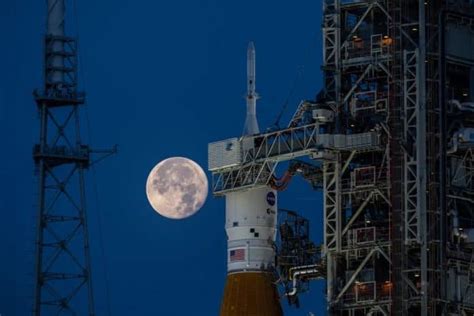
Bir yıldırım çarpmasının bu görüntüsü, 2 Nisan 2022 akşamı Florida’daki NASA’nın Kennedy Uzay Merkezi’ndeki Fırlatma Kompleksi 39B’de kaydedildi. 27 Ağustos Cumartesi öğleden sonra, Fırlatma sırasında yıldırımdan korunma sistemi kulelerine üç yıldırım çarpması oldu. Pad 39B – Kule 1’e bir saldırı ve Kule 2’ye iki saldırı. Kredi: NASA
<span class="glossaryLink" aria-describedby="tt" data-cmtooltip=" ” data-gt-translate-attributes=”[{” attribute=””>NASA’s mission management team for Artemis I met yesterday morning to review the status of operations and have polled “go” to proceed with the launch countdown. The countdown commenced at 10:23 a.m. EDT (7:23 a.m. PDT) on August 27, after the launch team arrived at their stations in the Rocco A. Petrone Launch Control Center at NASA’s Kennedy Space Center in Florida. Throughout the day, teams powered up the Orion spacecraft and the Space Launch System (SLS) rocket’s core stage and prepared the four RS-25 engines. Meteorologists with Space Launch Delta 45 predict a 70% chance of favorable weather for launch on Monday, August 29. The weather guidelines for NASA’s Artemis I flight test identify conditions to launch the agency’s Space Launch System and Orion spacecraft.
NASA held a prelaunch media briefing. Participants included: NASA ayrıca Ay’larında bir brifing (yukarıda gömülü) düzenledi.[{” attribute=””>Mars exploration plans with the following participants:
NASA’s Space Launch System rocket and Orion spacecraft are scheduled to lift off from Kennedy’s Launch Pad 39B during a two-hour launch window that opens at 8:33 a.m. EDT (5:33 a.m. PDT) on Monday, August 29. A lightning strike was recorded at Launch Complex 39B at NASA’s Kennedy Space Center in Florida during the evening of April 2, 2022. NASA’s Space Launch System (SLS) and Orion spacecraft were undergoing a prelaunch test called a wet dress rehearsal at the pad for the Artemis I mission. The lightning strike was recorded by cameras stationed at the pad and mobile launcher using a special filter called a “clear day frame,” which provides an overlay of the raw frame on a reference image. Artemis I will be the first integrated test of the SLS and Orion spacecraft. Credit: NASA As the Artemis I countdown progresses, rain and thunderstorms continued throughout yesterday afternoon at NASA’s Kennedy Space Center in Florida. Earlier yesterday afternoon, there were three lightning strikes to the lightning protection system towers at Launch Pad 39B – a strike to Tower 1, and two strikes to Tower 2. Fortunately, the initial indications are that the strikes were of low magnitude. A weather team has begun an assessment that includes collecting voltage and current data, as well as imagery. The data will be shared with a team of experts on electromagnetic environment efforts who will determine if any constraints on vehicle or ground systems were violated. Engineers will conduct a walkdown at the pad overnight, and if needed, conduct additional assessments with subsystems experts.
Fırlatma rampasındaki yıldırımdan korunma sistemi, roketi, uzay aracını ve mobil fırlatıcıyı korumak için yerleştirilmiş 600 metrelik üç kule ve katener telleri içerir. Kablolar neredeyse çapraz olarak yere uzanıyor ve yıldırım akımını roketten uzaklaştırıyor. Mühendisler bir gecede göbekler üzerinde hazırlıklar yapacak, çekirdek aşamaya güç verecek ve Orion ve Uzay Fırlatma Sistemi çekirdek aşaması pillerini şarj etmeye başlayacak. Giderek daha karmaşık hale gelen bir dizi görevin ilki olan Artemis I, insan varlığını Ay’a ve ötesine genişletmek için bir temel sağlayacak mürettebatsız bir uçuş testi olacak. Görev, SLS roketinin performansını gösterecek ve Orion’un Ay’ın yaklaşık 40.000 mil ötesine ve Dünya’ya geri döndüğü yaklaşık altı hafta boyunca yeteneklerini test edecek.
Artemis I yönetim ekibi, Artemis I lansmanı öncesinde Misyon Yönetim Ekibi toplantısının ardından bir lansman öncesi brifing sağlar. NASA’nın Uzay Fırlatma Sistemi ve Orion uzay aracı, 29 Ağustos’ta Ay çevresinde bir uçuş testinde merkezin fırlatma rampasından 39B fırlatılacak. Mürettebatsız görev, SLS roketinin Orion uzay aracını Ay’ın etrafında güvenli bir şekilde taşıma ve geri dönüş yeteneğini gösterecek. ajansın Artemis Programı için Dünya’ya kurtarma.

NASA’nın Florida’daki Kennedy Uzay Merkezi’ndeki Fırlatma Kompleksi 39B’de yıllar boyunca meydana gelen çeşitli yıldırım çarpmalarına bir göz atın. Etkinlik, ped ve mobil fırlatıcının yanı sıra Araç Montaj Binasına yerleştirilmiş yüksek hızlı kameralar tarafından kaydedildi. Gün ışığında gibi görünen görüntüler için, ham çerçevenin bir referans görüntü üzerine bindirilmesini sağlayan “net gün çerçevesi” adı verilen özel bir filtre kullanıldı. 39B rampasında, fırlatma araçları işlenirken ve rampadan fırlatılırken yıldırımdan korunma sağlamak için elektrik enerjisini pedin çevresine iletmek için kullanılan havai tellere sahip 600 fit uzunluğunda üç direk vardır. Yıldırım kuleleri hakkında daha fazla bilgi için buraya tıklayın.
Popular Articles
- 04 Jul Haberim var, askerin bakanıyım
- 13 Jul Ramazan’da Enerjinizi Korumanız İçin Bol Bol Protein: İftarlık Mantarlı Hindi Pirzola ve Sahurluk Hindili Mantarlı Muffin Nasıl Yapılır?
- 22 Jul Kur Korumalı Mevduatta Süreci Cumhurbaşkanının Yönetmesi Teklif Edildi
- 27 Jun Her Gün Defalarca Kontrol Ettiğimiz, Zamanın Aynası Olan Saatlerin Tarihi
- 15 Jul Karabükte otomobilin çarptığı motosikletteki 2 kişi yaralandı - Son Dakika Haberler
Latest Articles
- 29 Jun Silent Hill: Milyon Dolarlık Bir Markanın Domain’i Elinize Geçse Ne Yapardınız?
- 24 Jun Spotify Wrapped’inizi nasıl bulabilirsiniz?
- 14 Jul Gboard, Selfielerinizi GIFe Çevirmeye Hazırlanıyor
- 21 Jun Coca-Cola, Tüm Sosyal Medya Platformlarına Reklam Boykotuna Başlıyor
- 21 Jun Googlea Kullanıcılarını Kandırdığı İçin Dava Açıldı: Konum Paylaşımı İçin Baskı Yapıyor